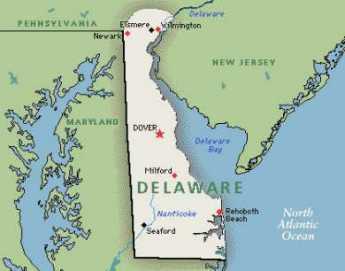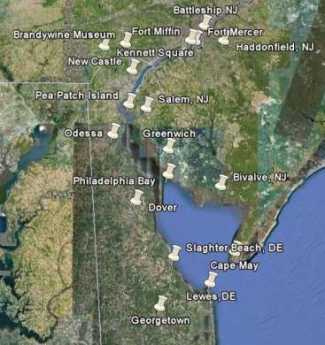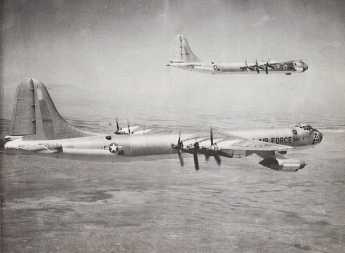Related Topics
Delaware (State of)
 Originally the "lower counties" of Pennsylvania, and thus one of three Quaker colonies founded by William Penn, Delaware has developed its own set of traditions and history.
Originally the "lower counties" of Pennsylvania, and thus one of three Quaker colonies founded by William Penn, Delaware has developed its own set of traditions and history.
Land Tour Around Delaware Bay
 Start in Philadelphia, take two days to tour around Delaware Bay. Down the New Jersey side to Cape May, ferry over to Lewes, tour up to Dover and New Castle, visit Winterthur, Longwood Gardens, Brandywine Battlefield and art museum, then back to Philadelphia. Try it!
Start in Philadelphia, take two days to tour around Delaware Bay. Down the New Jersey side to Cape May, ferry over to Lewes, tour up to Dover and New Castle, visit Winterthur, Longwood Gardens, Brandywine Battlefield and art museum, then back to Philadelphia. Try it!
Day Two: Rehoboth to Kennett Square
 So, if you want a glimpse of Delaware as it once was before the migrations, get in your car quick and take the tour.  |
Once you step off the Cape May-Lewes Ferry in Delaware, you can still find an occasional old soul who remembers when "the road" was built. The road they mean is the highway that finally connected Southern Delaware to Wilmington. Before 1925, travel between the two ends of that little state was by railroad, or by boat, mostly the Wilson Line. It is natural to suspect the railroad and the boat line might have lobbied against road building, and they certainly had an economic incentive. But there were social factors, too. Although it is a tiny state, Delaware has long been a collection of independent tribes. New Castle County is of course very Ivy League; the Wilmington area claims to have more PhDs than any other American county. Southern Delaware was a slave region, forcing the state to be in favor of the Union, but also in favor of slavery -- a border state. Furthermore, pirate lairs seem to have created a mixed race along the shore calling themselves "Moors"; intermarriage with Indians and/or Portuguese pirates has been speculated as a source of swarthiness. Along the Atlantic coast, it is claimed that pure Elizabethan English is still spoken. Furthermore, the maritime orientation of Lewes created more social affinity to Cape May and Philadelphia than to New Castle and Wilmington. Eastern shore Maryland was even closer. Finally, in 1923, Coleman DuPont gave up on persuasion, built a 98-mile highway from one end of his state to the other at a cost of $50,000 a mile, and just gave it to the state. The legislature at first wouldn't take it, thinking it was clever to let the rich DuPont fellow pay for its upkeep. However, the sight of a DuPont cavalry of highway patrolmen raised even more discomfort, so the legislature reconsidered, accepted the gift.
The legislature was right, in a perverse sort of way, because Wilmington folk promptly poured down to the beaches in the summer, to the duck blinds in the fall, retirees built houses where living was cheaper, southern Delaware children wanted to go North to college, the blonde girls of Swedish or Dutch ancestry went north to become someone's secretary, maybe marry him. The railroad and the boat line went bankrupt, segregation was declared unconstitutional, everybody got television and a pickup. Eventually, someone in the Chamber of Commerce got the idea of jiggering tax laws to encourage out-of-state retail, then banking, then credit cards. The transformation of Delaware into a tax haven brought welcome socio-economic competition to the monolithic Dupont Company, abating the benign hereditary aristocracy that had grown out of it. So, if you want a glimpse of Delaware as it once was before the migrations, get in your car quickly and take the tour. There have even been rumors that the Cape May ferry may close.

|
| Lewes Ferry |
Lewes was once a little seaport, but mostly a home for river pilots. There is a canal across the base of Cape Henlopen peninsula, and the pilots' imposing houses line the canal. But vacationers and sportsmen are now building waterfront houses as fast as they can, so old Lewes is getting lost. Rehoboth down the road has ocean beaches and higher land, so it offers suburban living at the beach, year-round. We don't plan to visit nearby Georgetown on this tour, but it's only ten miles away and presents an interesting legal anachronism in the Court of Chancery, for lawyers and historians to admire.
To take the Delaware turnpike from Lewes to Wilmington is quicker, but history is to be found by winding along Route 9, through the moors, marshes, and farmland. The Wesley Chapel is a place where John Wesley really preached in his tour to extend Anglicanism, and unintentionally to found the Methodist Church. The Bombay wildlife sanctuary is an interesting place to see migrating birds, although the birds may enjoy mosquitoes more than you do. You will be astonished to learn there were once so many peach trees in this area that Delaware was nicknamed the Peach State. Just outside Dover is the Air Force base, which somehow specializes in mortuary affairs during shooting wars. But there are real warplanes there, too, as became very evident during the Cuban Missle crisis. The sky seemed filled with huge eight-engine bombers, just circling around, waiting for orders to go lay an egg or two. The Air Force Base is a peculiarly international community to be living in rural Delaware; a pilot making regular trips to Guam had no difficulty keeping monthly appointments with me for a while.

|
| bomber |
If you watch for directions just south of the airbase, you can travel out in the farm country to the Delaware estate of John Dickinson. As a young man, Dickinson fought a bitter battle in the Pennsylvania Assembly against Benjamin Franklin's efforts to remove the Penn Family from control, and although he lost the King's decision, winning that decision caused Franklin to be essentially banished to England for years as a consequence. Much later, Dickinson swung the critical vote toward Independence by abstaining from voting on the point at the Continental Congress, but wouldn't sign the Declaration. Nevertheless, he volunteered to fight as a private when the British invaded. He started and ended life as a Quaker but was the richest man in the state in between times, was Governor of Pennsylvania and Delaware at the same time, freed his slaves but kept secret the discovery that it actually made his farms more profitable to hire farm workers. A truly remarkable person, living in what you will see were rather plain circumstances.

|
| Winterthur |
Dover itself is worth a quick trip to the colonial heart of it unless you become engulfed in traffic to the race track. Then a quick visit to the Blackbird pirate sanctuary of the pirate Blackbeard, and on to Odessa and New Castle, which are both real jewels. You can scarcely miss Odessa, which is at the narrowest neck in the Delmarva Peninsula, an isthmus that necessarily must eventually choke up with highways; Odessa has a Christmas festival worth a trip just for it. New Castle is far more uniform in appearance because it burned shortly after the Revolution and was rebuilt in pure Federalist style, then froze in time when the capital moved to Dover.
Then, skirt around Wilmington to the chateau country and try to decide between visiting Winterthur, Longwood Gardens, the Brandywine (Wyeth) Museum, the Brandywine Battlefield, and the mushroom area around Kennett Square. Generally speaking, Winterthur is at the top of the list.
If you left enough time, you may want to circle back through the Main Line suburbs, or through Swarthmore, to Chestnut Hill and Germantown, then down to center city Philadelphia. However, you may be tired, and just want to buzz back from Kennett Square by way of I-95.
Originally published: Thursday, April 05, 2007; most-recently modified: Thursday, May 16, 2019